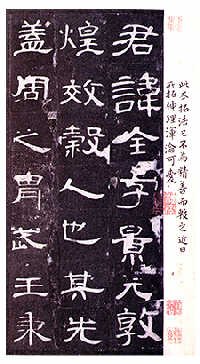This was China's first thorough character standardization movement led by the central government, and the uniform calligraphic style has great significance in pushing forward the development of Chinese characters.
 Lishu
Lishu
 Soon after theXiaozhuanbecame the official standard script, there arose one style called Sutizi (vulgar style), which was simplified from the scripts of the Qin State and used among the common people. Though Xiaozhuan was neater than the earlier scripts, it was still troublesome to common people. Even though it was not the standard, many people preferred using the Sutizi because it was faster and more convenient. Eventually some official documents came to be written with Sutizi. This script came to be calledLishu(clerical scripts). Legend has it thatLishuwas created by a man called Cheng Miao, but it is probable that Cheng simply worked to organize the Sutizi. TheLishuof the Qin Dynasty is called Qinli (Qin clerical scripts) or Guli (Archaic clerical scripts), while that of the Han Dynasty is called Hanli (Han clerical scripts) or Jinli (Modern clerical scripts).
Soon after theXiaozhuanbecame the official standard script, there arose one style called Sutizi (vulgar style), which was simplified from the scripts of the Qin State and used among the common people. Though Xiaozhuan was neater than the earlier scripts, it was still troublesome to common people. Even though it was not the standard, many people preferred using the Sutizi because it was faster and more convenient. Eventually some official documents came to be written with Sutizi. This script came to be calledLishu(clerical scripts). Legend has it thatLishuwas created by a man called Cheng Miao, but it is probable that Cheng simply worked to organize the Sutizi. TheLishuof the Qin Dynasty is called Qinli (Qin clerical scripts) or Guli (Archaic clerical scripts), while that of the Han Dynasty is called Hanli (Han clerical scripts) or Jinli (Modern clerical scripts).
The scripts ofLishurevised and modified the former fat and curved strokes to be flat, upright and horizontal. It completely changed the numerous original pictographic features and made the Chinese script more symbolic. The period of the change from Xiaozhuan toLishurepresents a huge revolution in the history of the development of the Chinese script. This great change is known as the Libian (Clerical revolution) .Lishubecame a main style during the Han Dynasty.
 Caoshu
Caoshu
WhenLishubecame the commonly- used style in the Han dynasty, there also existed another style known asCaoshu(Cursive script).Caoshuis the result of writingLishufaster, more carelessly and conveniently. The main function ofCaoshuwas for writing manuscripts and letters. Due to the speed with which it is written, some writing procedures are omitted and some strokes are combined together.Caoshufrom the Han Dynasty is called Zhang Cao (Zhang cursive scripts) because when compared to the Jinchao (Modern cursive script) of the Weijin period, it is still neater, more rule-bound, and easier to read.
